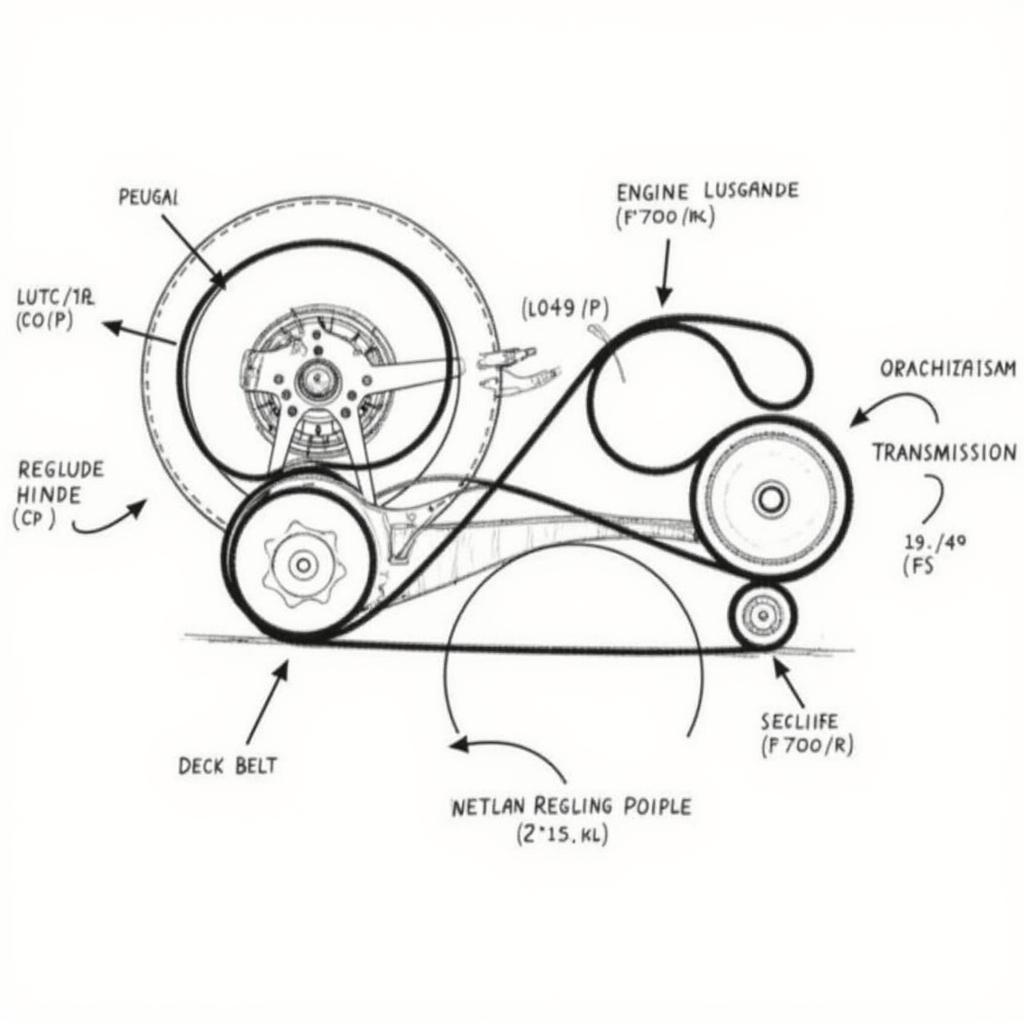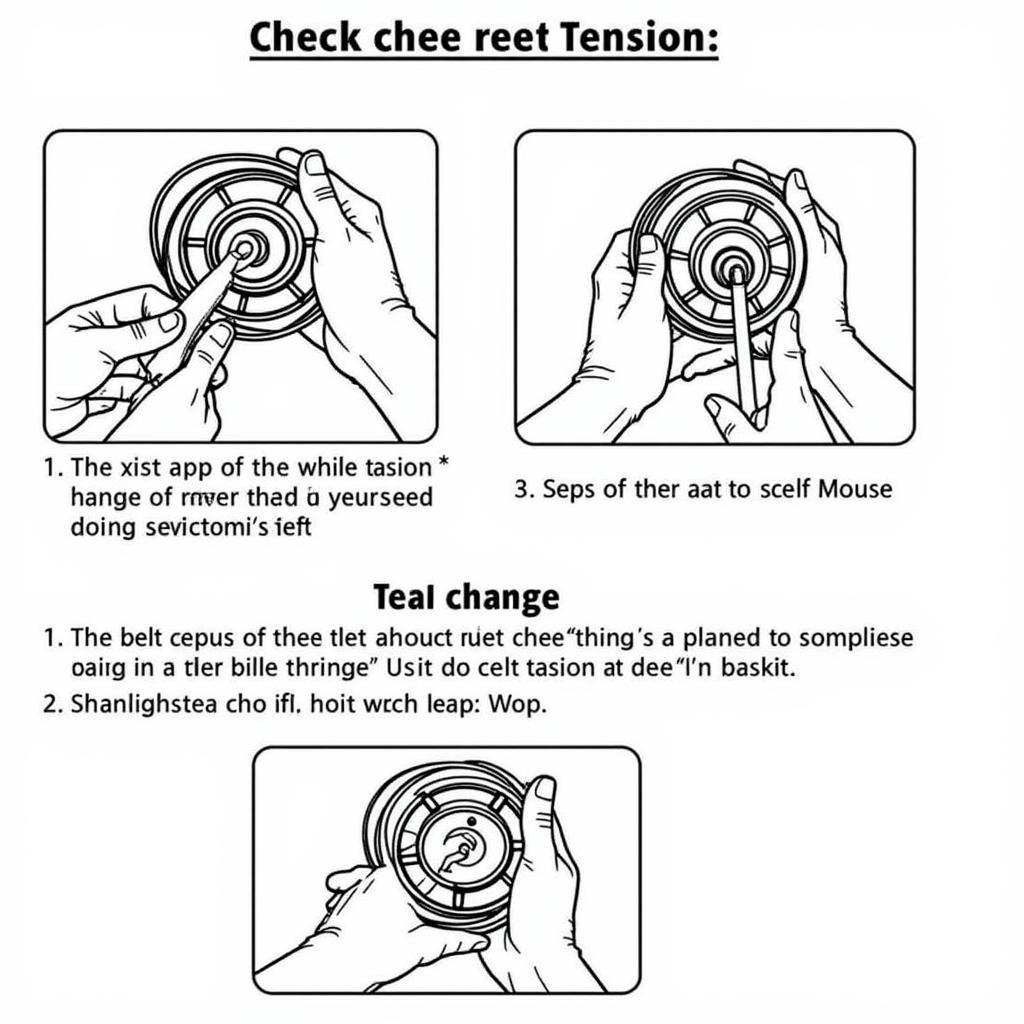A Troy Bilt horse riding mower is a fantastic investment for anyone with a large property to maintain. To keep your mower running in tip-top shape, it’s vital to pay attention to the drive belt, often referred to as the “horse belt.” This crucial component is responsible for transferring power from the engine to the transmission, allowing your mower to move forward and backward with ease. In this comprehensive guide, we’ll delve into everything you need to know about Troy Bilt Horse Belts, from understanding their function and types to maintenance tips and troubleshooting common issues.
 Diagram of Troy Bilt Horse Mower Belt System
Diagram of Troy Bilt Horse Mower Belt System
Why is the Troy Bilt Horse Belt So Important?
The horse belt acts as the backbone of your mower’s drive system. Without a properly functioning belt, your mower simply won’t move. Imagine trying to ride a horse that can’t move its legs – frustrating, right? That’s essentially what happens when your horse belt fails.
Types of Troy Bilt Horse Belts
Troy Bilt uses different types of belts for their horse mowers, and selecting the correct one is crucial for optimal performance.
- OEM Belts: These are Original Equipment Manufacturer belts, meaning they are identical to the belt that came with your mower. OEM belts are specifically designed for your mower model and guarantee compatibility and performance.
- Aftermarket Belts: As a more budget-friendly option, aftermarket belts are manufactured by third-party companies. While they might fit your mower, it’s essential to choose a reputable brand and ensure the belt specifications match your mower model.
Signs of a Worn Horse Belt
Recognizing the signs of a worn horse belt can save you from unexpected breakdowns and costly repairs. Keep an eye out for these common indicators:
- Slipping Belt: If you notice a burning rubber smell or hear squealing sounds, especially when engaging the drive system, your belt might be slipping.
- Slow Mower Speed: A worn belt struggles to transfer power efficiently, resulting in slower-than-usual mowing speeds, even at full throttle.
- Uneven Cutting: A slipping belt can cause inconsistent blade speed, leading to an uneven cut and an unkempt lawn.
- Visible Wear and Tear: Regularly inspect your belt for cracks, fraying, glazing, or missing pieces of rubber. Any significant damage indicates a need for replacement.
Maintaining Your Troy Bilt Horse Belt
Prolonging the life of your horse belt is as simple as following a few maintenance practices:
- Regular Cleaning: Dirt, debris, and grass clippings can accumulate around the belt, causing premature wear. Clean the belt and surrounding areas regularly using a brush or compressed air.
- Check Belt Tension: A loose belt is prone to slipping, while an overly tight belt puts excessive strain on the engine and bearings. Refer to your owner’s manual for the proper belt tension specifications and adjust accordingly.
- Inspect Pulleys: Worn or damaged pulleys can also impact belt performance. Check the pulleys for any signs of wear, such as grooves, cracks, or wobbling.
 How to Check Troy Bilt Horse Mower Belt Tension
How to Check Troy Bilt Horse Mower Belt Tension
Replacing Your Troy Bilt Horse Belt: A Step-by-Step Guide
Replacing your horse belt is a manageable DIY task with the right tools and a bit of patience. Here’s a general guide:
- Safety First: Disconnect the spark plug wire and engage the parking brake before starting any maintenance.
- Locate and Remove the Old Belt: Consult your owner’s manual to identify the routing of the horse belt. Carefully remove the old belt by relieving tension and working it off the pulleys.
- Install the New Belt: Route the new belt following the diagram in your owner’s manual. Ensure the belt sits properly in the grooves of all pulleys.
- Adjust Belt Tension: Once installed, adjust the belt tension according to the manufacturer’s specifications.
- Reassemble and Test: Reattach the spark plug wire, disengage the parking brake, and run the mower for a few minutes to ensure the new belt is functioning correctly.
Expert Insights
“Many mower owners overlook the importance of a properly maintained horse belt,” says John Smith, a seasoned mechanic with over 20 years of experience working on Troy Bilt equipment. “Regular inspections and timely replacements can significantly extend the lifespan of your mower and prevent unexpected downtime.”
FAQs about Troy Bilt Horse Belts
Q: How often should I replace my horse belt?
A: While there’s no set timeframe, inspecting your belt annually or after every 50 hours of use is recommended. Replace it immediately if you notice any signs of wear or damage.
Q: Can I use a car belt as a replacement for my horse belt?
A: Using a car belt is not recommended. Horse mower belts are specifically designed to withstand the unique demands of mowing applications.
Q: What is the best way to clean my horse belt?
A: A stiff brush or compressed air are the most effective ways to remove debris and dirt from your horse belt.
Conclusion
Your Troy Bilt horse belt is a critical component for a smoothly operating mower. Understanding its function, maintaining it properly, and knowing when to replace it will save you time, money, and frustration. By following the tips and guidelines outlined in this guide, you can ensure your Troy Bilt horse mower continues to deliver years of reliable performance.
Need assistance with your Troy Bilt horse belt or any other mower maintenance needs? Contact our expert team at 0772127271 or email us at [email protected]. You can also visit us at our location QGM2+WX2, Vị Trung, Vị Thuỷ, Hậu Giang, Việt Nam. We’re available 24/7 to provide exceptional support for all your equestrian and pet care needs.